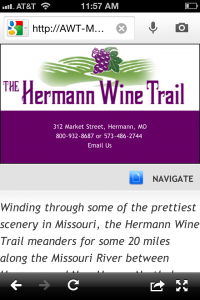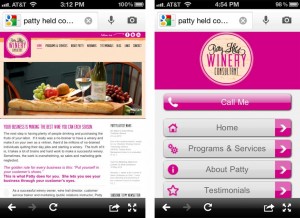Is Your Winery Website Mobile Friendly?
I am on a mission to encourage wineries to focus on their websites. Having a mobile friendly website can have a huge impact on the number of visits to your business. A simple question from a VESTA student in the Winery Marketing class I teach started my most recent quest to help wineries improve their websites. The student’s question, “How do you know if a website is mobile friendly?”
That’s a great question. After some research, I discovered that most wineries’ websites are not mobile friendly. Here’s how to tell if a website is compatible with most smart phones: Open the website on your smart phone. If the text in the website can’t be read easily without scrolling and zooming, the website is not harmonious with today’s sophisticated mobile devices.
So why do you want your winery’s website to be mobile friendly?
Let’s start with some eye-opening statistics:
1. 35% of American adults have a smartphone and 87% of smartphone owners access the internet on their mobile devices. (Hubspot)
2. Mobile searches have grown by 400% since 2010. (Gartner 2010, Google Mobile Optimization Webinar 2011)
3. About half of all smart phone users are between the ages of 25-45. (www.websearchsocial.com)
4. 61% of users call a business after searching, and 59% visit the location. (Mobile Movement; Understanding Smartphone Users 2011)
Are you convinced now that your website needs to be mobile friendly? Missing out on all the consumers who are searching the web on their mobile devices looking for a winery to visit or a wine to buy is a huge lost opportunity.
See related story: Five Steps for Remarkable Website Design
There are several ways to optimize a website for mobile devices:
1. The first method is to create a different website for mobile viewers. A web developer can set up a mobile redirect by placing a line of code on a website’s homepage that determines the size of the viewer’s browser screen. Whether a web visitor is sent to the special mobile site or stays on the regular website depends on the size of the visitor’s browser screen. Here is an example of a separate mobile website that has a redirect.

2. The second method is to install what’s called a “mobile plugin.” On a WordPress website, a mobile “plugin” is a software addition that takes existing content and makes it readable. (Midwest Wine Press is a WordPress website.) With this method, website content might also need to be tweaked to make it mobile friendly. If you are committed to on having a custom designed website with lots of bells and whistles, then this option might not be for you. But using WordPress and plug ins is less expensive while accomplishing the goal of creating a site visitors can read on a cell phone. Here is an example of a mobile plugin that was added to a WordPress website.

3. Another way to create a mobile friendly website is to add a Mobile Template. I tried this method and was surprised how easy it is. First, go to HowToGoMo.com, a Google service that shows how an existing website looks on a smart phone. This tool provides a report on how well a website functions on a mobile phone and how to make a website more mobile friendly. Next, you can build a new site in minutes with the site-builder tool from Dudamobile, an internet based app developer. It really works. I built my new website in minutes and added a ‘Call Me” button so clients can call me from my website. Just think how happy your customers will be if they can call to see if your business is open. Below is a before and after photo of my website taken from a smart phone. And, even better, all this is free!

Here’s a quick review of important considerations for a mobile website:
1. Quick display. Mobile users expect a site to load in less than 5 seconds according to Google. If your site takes too long to load, you may lose a prospective customer.
2. Simple navigation. Use big clear headings; Hours, Events, Wines, Location, Contact Us. A visitor may be looking for a winery that has entertainment for that afternoon.
3. Easy to read. Visitors are happier if they don’t have to pinch and zoom.
4. Keep it local. 95 % of smart phone users have searched for local information. Make it easy for them to find you by including address, maps and directions.
5. Add click-to-call dialing. Help customers connect instantly to the winery.
A great mobile experience can increase your traffic and customer satisfaction. Follow these steps today to make your website mobile friendly.
For more information on mobile friendly websites please visit www.pattyheldconsulting.com.
[wp_geo_map]




